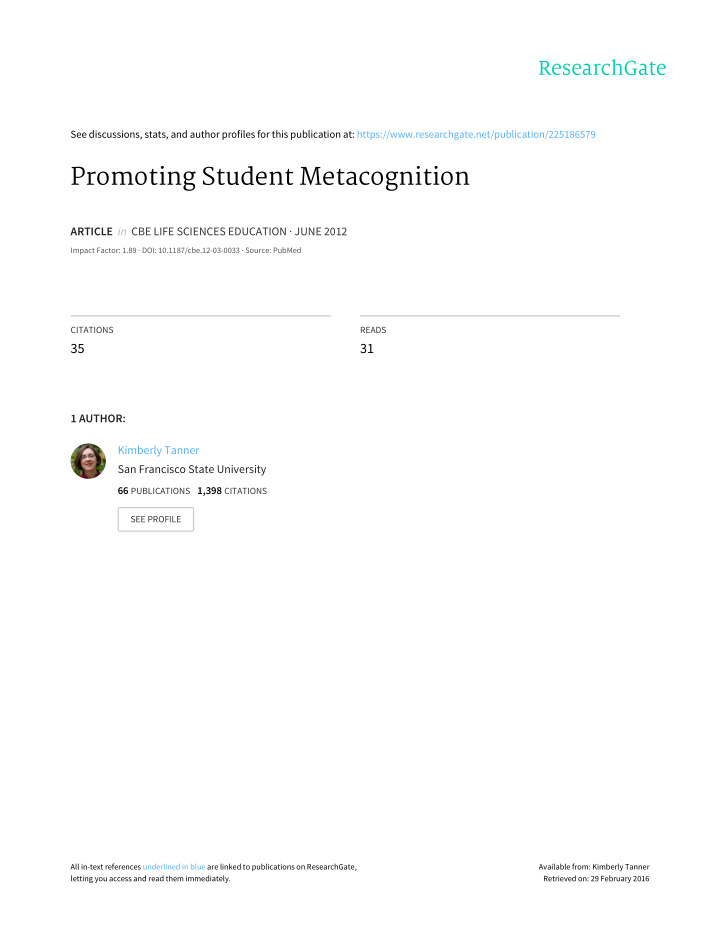



See discussions, stats, and author profiles for this publication at: https://www.researchgate.net/publication/225186579 Promoting Student Metacognition ARTICLE in CBE LIFE SCIENCES EDUCATION · JUNE 2012 Impact Factor: 1.89 · DOI: 10.1187/cbe.12-03-0033 · Source: PubMed CITATIONS READS 35 31 1 AUTHOR: Kimberly Tanner San Francisco State University 66 PUBLICATIONS 1,398 CITATIONS SEE PROFILE All in-text references underlined in blue are linked to publications on ResearchGate, Available from: Kimberly Tanner letting you access and read them immediately. Retrieved on: 29 February 2016
CBE—Life Sciences Education Vol. 11, 113–120, Summer 2012 Feature Approaches to Biology Teaching and Learning Promoting Student Metacognition Kimberly D. Tanner Department of Biology, San Francisco State University, San Francisco, CA 94132 Learning how to learn cannot be left to students. It must brought them to her weekly study group with peers from her course be taught. (Gall et al ., 1990) lab section. There, she says, she got most of her questions answered and lots of her confusions cleared up. She has come to office hours Imagine yourself as the instructor of an introductory un- to ask you about a couple of things that she did not figure out before dergraduate biology course. Two students from your course the exam that she thinks she probably missed. She is not too worried independently visit your office the week after the first exam. about her score on the exam, because most of the material related to Both students are biology majors. Both regularly attend class problems and concepts that she felt had been thinking about a lot. and submit their assignments on time. Both appear to be So, what is different about Josephina and Maya? No doubt eager, dedicated, and genuine students who want to learn bi- many things, including their educational histories, their per- ology. During each of their office hours visits, you ask them to sonalities, and more. However, one key difference in their share how they prepared for the first exam. Their stories are approach to their studies is evident from their stories. They strikingly different (inspired by Ertmer and Newby, 1996). appear to be strikingly different in knowing how to learn, During office hours, Josephina expresses that she was happy the being able to monitor their own understanding, being reflec- exam was on a Monday, because she had a lot of time to prepare the tive about what they understand and do not understand, and previous weekend. She shares that she started studying after work being able to strategize about how to resolve their confu- on Saturday evening and did not go out with friends that night. sions. They are different in their ability to use metacognitive When queried, she also shares that she reread all of the assigned approaches in their learning. textbook material and made flashcards of the bold words in the text. She feels that she should have done well on the test, because she studied all Saturday night and all day on Sunday. She feels that she did everything she could do to prepare. That said, she is worried INTRODUCING METACOGNITION about what her grade will be, and she wants you to know that she The importance of metacognition in the process of learning studied really hard, so she should get a good grade on the exam. is an old idea that can be traced from Socrates’ questioning Later in the week, Maya visits your office. When asked how she methods to Dewey’s twentieth-century stance that we learn prepared for the first exam, she explains that she has regularly more from reflecting on our experiences than from the actual reviewed the PowerPoint slides each evening after class since the experiences themselves (Dewey, 1933). What is more recent is beginning of the term 4 weeks ago. She also read the assigned the coining of the term “metacognition” and the emergence of textbook pages weekly, but expresses that she spent most of her time a metacognition research field in the last four decades. Cred- comparing the ideas in the PowerPoint slides with the information ited to developmental psychologist John Flavell in a publica- in the textbook to see how they were similar and different. She found tion from the 1970s, metacognition is used in different disci- several places in which things seemed not to agree, which confused plines in different ways, and a common, succinct definition her. She kept a running list of these confusions each week. When appears to be elusive in the literature. Below is an excerpt you ask what she did with these confusions, she shares that she from Flavell’s original writing, as well as several additional definitions and conceptualizations from different sources: DOI: 10.1187/cbe.12-03-0033 Address correspondence to: Kimberly Tanner (kdtanner@sfsu.edu). � 2012 K. D. Tanner. CBE—Life Sciences Education c c � 2012 The American Society for Cell Biology. This article is distributed Metacognition refers to one’s knowledge concerning by The American Society for Cell Biology under license from one’s own cognitive processes or anything related to the author(s). It is available to the public under an Attribution– them, e.g., the learning-relevant properties of informa- Noncommercial–Share Alike 3.0 Unported Creative Commons tion or data. For example, I am engaging in metacogni- License (http://creativecommons.org/licenses/by-nc-sa/3.0). tion if I notice that I am having more trouble learning � ” and “The American Society for Cell Biology R � ” are regis- “ASCB R A than B; if it strikes me that I should double check C tered trademarks of The American Society for Cell Biology. before accepting it as fact. (Flavell, 1976) 113
Recommend
More recommend